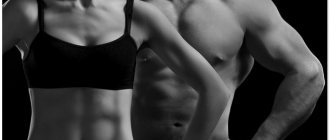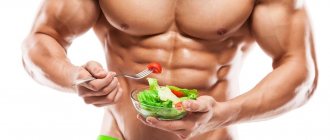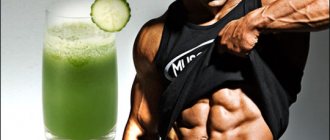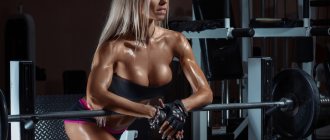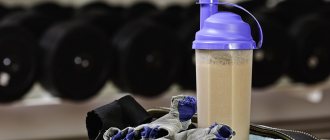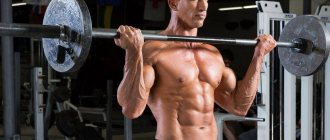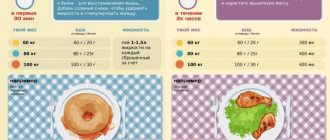Let's decide on proteins, fats and carbohydrates!
To gain high-quality muscle mass, our daily diet should be in the following proportion:
Proteins – 25%
Fats – 15%
Carbohydrates – 60%
This means that of everything we ate during the day there should be 25% proteins, 15% fats and 60% carbohydrates, while it is worth considering that the calorie content should also be fixed, no less, no more. I have already calculated in the article, the link to which is in the first paragraph, that I essentially need 3850 calories
. The calculation was rough, therefore, everything can be adjusted in the process, depending on your condition and result.
1 gram of protein contains 4 calories, 1 gram of carbohydrates - 4 calories, 1 gram of fat - 9 calories.
Now let’s calculate how much protein, fat and carbohydrates I need per day, based on the fact that we have a daily proportion (protein - 25%, fats - 15%, carbohydrates - 60%):
Squirrels
— 3850*0.25/4 = 240 g
Fats
— 3850*0.15/9 = 64 g
Carbohydrates
— 3850*0.6/4 = 577 g
In the article, linked in the first paragraph, I wrote that for 1 kg of your body weight you need 2 grams of protein and 4 grams of carbohydrates, which is very contradictory with the data that you see above. But I prefer the current calculation, where we get the norm of protein, fat and coal based on calories, which is more correct from a physiological point of view. You can’t just say that we need 2 grams of protein per 1 kg and that’s the weight. In any case, if you don’t try, you won’t know, therefore, you always need to experiment, look at how you feel, clearly measure the readings and adjust the program to bring everything to the ideal.
The role of carbohydrates and their differences among themselves
Most likely you know that all carbohydrates are divided into two large groups:
- complex carbohydrates;
- simple carbohydrates.
The difference between these two types of carbohydrates is the length of the molecular chain. Simple carbohydrates have a short chain that quickly raises blood sugar levels and also quickly lowers them. Such carbohydrates should be reduced as much as possible from the diet, since they provide energy only for a short period of time, and the high sugar content in them only leads to a gain of fat mass. When gaining muscle mass, simple carbohydrates should be consumed no more than 100 g per day and mainly in the first half of the day.
Complex carbohydrates have a long molecular chain, which allows you to get a boost of energy for a long time, launching all the necessary processes in the gastrointestinal tract and raising glucose levels gradually without sudden jumps.
Important nutritional details.
Don't think that everything will be so easy. In order to gain high-quality muscle mass, you need to take into account many small but significant points.
70% of the main diet before 16.00!
Before 16.00 we should eat 70% of our daily diet.
We reduce carbohydrates throughout the day, and increase proteins!
The highest carbohydrate foods should be breakfast and lunch; there should be practically no carbohydrates for dinner. The same principle works for protein; in the morning it is practically not needed, but dinner is the highest protein intake. If for carbohydrates the decline graph should be pronounced, then for proteins it is not so significant, you can even say that there is a straight line. Our body needs a small amount of fat, therefore, during the day it will evenly shake itself out of all foods.
Fresh fruits and vegetables are carbohydrates.
We eat fresh fruits separately from the main meals, we will snack on those fruits, because when digested they begin to ferment, alcoholic fermentation, which makes digestion difficult, there will be heaviness and bloating. In general, more harm than good. Vegetables can be combined with main dishes, in the form of salads.
Diet and equal portions.
Breakfast should be from 7 - 9 am. If I always wake up at 5-6 in the morning, then my wife sleeps until 10-11, which is why, it seems, I will have to cook breakfast myself, or teach her to wake up earlier.
Don’t stretch your stomach, distribute your daily diet into adequate portion sizes, if you can’t force yourself to eat heavily in the morning, then train, every time you can’t force yourself, after 21 days you’ll get used to it. It would not be very correct if you combine lunch and breakfast and fill your belly to capacity, expecting a positive result.
Protein is a building material
Heh (at first it was funny, but now, frankly speaking, it’s sad), in general, usually, when a person has been and continues to visit the gym for a long time and has achieved, so to speak, “good results,” he comes to study/work and here from the mouths of those around him people, questions like: “did you pump yourself or on proteins?” well, in that spirit...”
Many have heard (perhaps firsthand) and understand what we are talking about... So, I want to clarify this point once and for all, assuring you that all this is complete nonsense. Protein is just protein, it's just food, exactly the same as regular food products (for example, cottage cheese in bodybuilding or meat).
In general, when you count (if you do it at all, because many are lazy, and in vain, it’s not just anyone who needs it, but you.. think about it) the amount of protein, remember two rules:
- You need to consume at least 2 grams of protein per day, for every kg of your weight (in general, I recommend studying the article => “How much protein is needed for muscle growth”)
- We calculate only protein of animal origin or from supplements (sports nutrition), we do not take into account vegetable protein.
Ps Animal protein is fish, poultry, any meat, eggs, dairy products (cottage cheese, milk, kefir).
Pps. Animal proteins are much better than plant proteins due to their better amino acid profile. Actually for this reason, all experienced bodybuilders, including us (after all, I also recommend you) do not take vegetable protein into account when calculating your daily protein intake.
We decide on food products.
Products rich in carbohydrates that I like and which I can easily buy in China: potatoes (both plain and sweet potatoes), noodles and pasta, mushrooms, walnuts, peanuts, muesli, porridge (oatmeal, rice, buckwheat, wheat, corn), semolina.
Protein-rich foods that I like and can easily buy in China: legumes, eggs, poultry, fish, seafood, cheese, cottage cheese.
Vegetables and fruits that I like and that I can easily buy in China: tomatoes, cucumbers, beets, carrots, cabbage (cauliflower, broccoli, cabbage), greens (parsley, dill, celery, cilantro, lettuce), eggplant, avocado, pumpkin, apple, bananas, pineapple, watermelon, kiwi.
We won’t pay attention to fats, because if you don’t eat all sorts of rubbish: chips, butter, mayonnaise, sauces, cream, etc., then there will be enough fat from protein and carbohydrate foods.
As I go to the store and search for information about certain products, the list of what I will include in my diet will be adjusted.
Diet and basic calculations.
The routine of my working day, that day of training, will be as follows, although on a day off, a day without training, nothing much will change:
5-6 am - wake up, have a cocktail
8.00 - breakfast
11.00 - snack
14.00 - ate before training
16.00 – training
18.30 - ate after training
21.00 - dinner
22.00 – cocktail
Of course, this regime is not very ideal, but you need to look at reality; it simply won’t work out differently. The main thing to remember is to eat every three hours, in even portions, what you have prepared for yourself in advance, or by understanding which foods contain a lot of carbohydrates and which contain protein.
And so, before 16.00 we must cut down 70% of the entire diet, which means that by 14.00 I should already consume 240 * 0.7 = 168 grams of protein
and 577 * 0.7 =
403 grams of carbohydrates
, 3850 calories * 0.7 =
2695 calories
.
5-6 am - drank a cocktail. I already wrote that a blender is an excellent solution for cocktails. We interfere:
1) Olimp Gain Bolic 6000, per serving 376 calories, 75 grams of carbohydrates (of which 32 grams are sugar), 15 grams of proteins. We will count only complex carbohydrates, as the fast ones are enough to wake you up. 75-32 = 43 grams of complex carbohydrates. (What sports supplements should I take to build muscle?)
2) 2 pieces of raw eggs - 2 * 6.3 g = 12.6 g protein, 2 * 0.34 = 0.68 g carbohydrates, 2 * 70 = 140 calories
3) 1 apple, medium size, without peel, without seeds (150-200 g) - 19.6 g carbohydrates, 0.8 g protein, 94 calories
4) 1 piece banana (150-200 g) - 3 g protein, 42 g carbohydrates, 180 calories
5) Dry oat flakes (30 g) - 3.57 g protein, 20.79 g carbohydrates, 110 calories
If there are still carrots, broccoli, beets or something else (boiled), then you can also beat everything, this will not affect the taste, but it will affect the supply of useful elements to the body.
The cocktail turned out to be 376+140+94+180+110 = 900 calories
, 15+12.6+0.8+3+3.57 =
34.97 g protein
, 43+0.68+19.6+42+20.79 =
126 g carbohydrates
.
Without a blender, the smoothie would only be 376 calories, 15 grams of protein and 43 grams of carbohydrates, since I make everything with water.
Before 14.00 I still need to consume 2695-900 = 1795 calories, 168-34.97 = 133.03 g of protein, 403-126 = 277 g of carbohydrates.
Protein-carbohydrate diet sample menu. General rules
Diets based on alternating protein and carbohydrate diets (BEACH diet) are designed for intensive weight loss due to fat deposits. A protein-carbohydrate diet for weight loss in various versions is widely used by athletes involved in bodybuilding for the so-called “cutting”, aimed at reducing the subcutaneous fat layer, which allows not only to lose weight, but also to improve muscle definition and body expressiveness.
Along with such specific goals, the BEACH diet is also used for weight loss (weight loss). At the same time, with such a nutritional system, the body uses primarily fats to obtain energy, avoiding loss of body weight due to the breakdown of proteins, that is, muscle mass is not used as metabolic fuel.
Detailed description of the BUTCH diet
The BUC diet consists of microcycles, the minimum duration of which is four days. The first two days - with a predominantly protein diet. During this period, the body receives an insufficient amount of carbohydrates and a reorientation of metabolic processes to gluconeogenesis occurs, in which the formation of energy occurs due to non-carbohydrate components - mainly glycerol, pyruvic and lactic acid, fatty acids, that is, active consumption of glycogen begins and the mobilization/oxidation process accelerates free fatty acids (burning fat deposits).
After a two-day protein diet, glycogen reserves in the body are exhausted and in order to prevent the use of amino acids (protein) as “metabolic fuel”, glycogen reserves in the body must be replenished, which is achieved by switching to a high-carbohydrate diet on the third day. But since it is impossible to completely replenish the required amount of glycogen in the body in one day, on the fourth day a mixed diet is prescribed, which provides a more moderate carbohydrate content in combination with a physiologically normal protein content. Next, the protein-carbohydrate cycle repeats.
Scheme of one cycle of the BEACH diet - two days diet with predominantly protein consumption + one day high carbohydrate diet + one day mixed diet:
- The first two days - the amount of protein in the diet at the rate of 3-3.5 grams/kilogram of your optimal (given) weight. That is, if your weight is 65 kg, and you want to lose weight to 60 kg, then you need to consume 3 * 60 g of protein (180 g). The total consumption of carbohydrates in these 2 days is at the level of 25-30 g / day and fat - up to 25-30 g.
- The third day - the protein content in the diet is reduced to 1-1.5 g/kg, and the carbohydrate content - to 6 g/kg of the desired weight. At the same time, the calorie content of the daily diet of the previous two days should be maintained.
- Fourth day - the diet should contain approximately equal proportions of proteins (up to 2.5 grams) and carbohydrates (up to 3 grams). Fat content at thirty grams/day.
Fundamentally important for the BEACH diet is the total calorie content of the daily diet, which, depending on the level of physical activity, should be at the level of 1200-1500 kcal.
The duration of such a diet should not exceed one month (7-8 cycles). This is due, on the one hand, to an unbalanced diet, and on the other hand, to the appearance of a “plateau” effect after this period of being on a BEACH diet (cessation/slowdown of weight loss), due to the body’s adaptation to this type of nutrition.
To speed up metabolism and improve metabolism, meals should be fractional (5-6 times/day). The amount of free fluid is 1.5 - 2.0 l/day. The amount of salt should be reduced and the consumption of salty foods limited.
It is recommended to prepare dishes using dietary methods of processing food - steaming, boiling, baking, stewing. Frying food is not allowed. An important condition for the effectiveness of this diet is the mandatory adequate physical activity, especially on protein days, when the glycogen content in the body is low and the metabolic processes of intense fat burning are triggered. Particularly useful are strength loads and dynamic exercises (jumping rope, cycling), which stimulate metabolic processes.
Other BEACH diet schemes have been developed:
- 2 protein days + 2 carbohydrate days + 2 mixed days;
- 3 protein + 1 carbohydrate day + one mixed day;
- 5 protein days + 2 carbohydrate days.
Microcycles with a large number of protein days are also suitable for gaining weight, muscle mass, which will grow, but the fat layer will decrease. The most important condition for such a result is high power loads. However, the optimal option is a cycle with 2 protein days, since an increase in the number of days with a protein diet is more difficult for the body to tolerate. Getting out of the BUTCH diet is not difficult. To do this, after finishing the diet after the last mixed day, eat for another 5-7 days according to the mixed day diet and switch to your usual diet.
Breakfast.
Since carbohydrates are eliminated in the evening, breakfast is the highest carbohydrate meal of the day. I have 3 more meals, and I need to consume 277 grams of carbohydrates, which means 120-130 grams of carbohydrates should come for breakfast. It is best to eat porridge for breakfast, it contains a lot of carbohydrates, fiber, and is good for the stomach.
My wife prepares rice, oatmeal, buckwheat porridge with the addition of pumpkin, nuts, raisins, etc. It is important to use oatmeal not from five-minute oatmeal, which has been poured with boiling water, or boiled for 5 minutes and it’s done, but from whole grains.
My portion of oatmeal, which my wife always prepares, is 75 grams of porridge, those are 60 calories, 1.875 grams of protein, 10.423 grams of carbohydrates. Let another 10-20 grams of walnuts, which will be 130 calories, 3.04 grams of protein, 1.4 grams of carbohydrates.
Breakfast, which is usually prepared by the wife - 190 calories, 4.915 g protein, 11.823 g carbohydrates.
What carbohydrates are healthy?
Carbohydrates can be simple, these include: glucose, fructose, galactose. Foods containing monosaccharides have a sweetish taste. Monosaccharides quickly break down and release sugar (that is, energy) to the body.
Complex carbohydrates are starch, fiber and pectin. Their decay occurs slowly, energy flows evenly, and a feeling of saturation appears.
It is impossible to say which carbohydrates are more useful; balance is important . Fast carbohydrates should make up no more than 35% of the total. You can increase the dose if you have to do one-time work that requires concentration, physical activity, etc.
High Carbohydrate Diet for Weight Loss
It is impossible to say which carbohydrates are more beneficial; balance is important.
Many nutritionists advise sticking to a diet rich in complex carbohydrates. They give a feeling of fullness, produce the hormone of joy, slowly breaking down, provide the body with energy for the whole day, and also speed up metabolism.
Important! Such weight loss is not recommended for people who have problems with the gastrointestinal tract, especially in the acute stage, as well as for diseases of the gallbladder and liver. Pregnant women and people with weakened immune systems should consult a doctor first.
Rules that this diet requires:
- frequent split meals (5-7 times a day);
- reducing the amount of salt;
- drinking at least 1.5 liters of clean water;
- last meal no later than 19:00;
- single volume of food no more than 200 ml;
- cooking steamed, boiled, baked and stewed food (fried excluded).
List of products allowed and prohibited for use:
| Acceptable | Prohibited |
| Any vegetable | Alcoholic and carbonated drinks |
| Fruits (except bananas and grapes), berries | Smoked meats |
| The whole range of whole grain cereals | Fast food |
| Pasta (durum wheat) | Butter buns |
| Legumes (lentils, beans, peas, etc.) | Sweets, cakes, other confectionery products |
| Lean meat | Ketchup, mayonnaise, fatty sauces |
| Bird | Sugar |
| Low-fat fish | Fatty milk substances |
| Nuts | Dishes with lots of spices |
| Milk products | Semi-finished products |
| Vegetable oils | Marinades |
Be sure to read: Pectin: what it is, what it contains, where it is used, what it is needed for, list of products
The diet is designed for 14 days, weight loss reaches 5-8 kg.
An approximate menu for a week is presented in the table (during the next 7 days the diet is repeated or goes in reverse order).
| Day of the week | Eating | Time | Products |
| Monday | Breakfast | 8:00 | Buckwheat porridge in water, a glass of kefir |
| Lunch | 10:00 | A couple of oranges | |
| Dinner | 12:00 | Stewed beans with carrots and tomatoes | |
| Afternoon snack | 14:00 | Green salad with cucumbers | |
| First dinner | 17:00 | Oatmeal porridge with water and fruit | |
| Second dinner | 19:00 | Kefir (1 glass) | |
| Tuesday | Breakfast | 8:00 | Oatmeal porridge with fruits, boiled in water |
| Lunch | 10:00 | Apple smoothie | |
| Dinner | 12:00 | Egg and cheese salad | |
| Afternoon snack | 14:00 | Milk cocktail with strawberries | |
| First dinner | 17:00 | Cabbage stewed with any poultry | |
| Second dinner | 19:00 | Berry jelly | |
| Wednesday | Breakfast | 8:00 | Green tea, toast, peanut butter |
| Lunch | 10:00 | Pear | |
| Dinner | 12:00 | Vegetable puree soup | |
| Afternoon snack | 14:00 | Freshly squeezed juice | |
| First dinner | 17:00 | Vegetables, fish steak | |
| Second dinner | 19:00 | Kefir (1 glass) | |
| Thursday | Breakfast | 8:00 | Cottage cheese, mashed with berries |
| Lunch | 10:00 | Slice of bread with meat and vegetables | |
| Dinner | 12:00 | Low-fat cabbage soup without meat | |
| Afternoon snack | 14:00 | Grapefruit | |
| First dinner | 17:00 | Stuffed peppers | |
| Second dinner | 19:00 | Fruit jelly | |
| Friday | Breakfast | 8:00 | Carrot salad, yogurt without fruit |
| Lunch | 10:00 | Kiwi (2 pcs.) | |
| Dinner | 12:00 | Vegetable soup with beans | |
| Afternoon snack | 14:00 | Yogurt without fruit | |
| First dinner | 17:00 | Stewed rice with mushrooms | |
| Second dinner | 19:00 | Fruit tea | |
| Saturday | Breakfast | 8:00 | Barley porridge covered with yoghurt |
| Lunch | 10:00 | Cocoa | |
| Dinner | 12:00 | Fish soup | |
| Afternoon snack | 14:00 | Fruit jelly | |
| First dinner | 17:00 | Rice with vegetables | |
| Second dinner | 19:00 | Cocktail (banana with milk) | |
| Sunday | Breakfast | 8:00 | Cottage cheese with pieces of fruit |
| Lunch | 10:00 | A pair of tangerines | |
| Dinner | 12:00 | A couple of baked potatoes | |
| Afternoon snack | 14:00 | Beet salad | |
| First dinner | 17:00 | Spaghetti with mushrooms | |
| Second dinner | 19:00 | Yogurt (1 cup) |
Diet to increase muscle mass
To gain muscle mass, high-calorie foods must be used; the process occurs with a high level of physical training.
The nutritional value of food for a day is calculated as follows: body weight is multiplied by 30, then 500 is added (for women, reduce the figure slightly). Distribute the resulting amount of calories over 5-7 meals.
The menu should consist of:
- carbohydrates (40-60% of food);
- proteins (25-35%);
- fats (15-25%).
It is based on slow carbohydrates. Sweets, baked goods, alcohol, fried and fatty foods are excluded.
An approximate weekly meal plan is described in the table:
| Day | Eating | |||||
| 1 | 2 | 3 | 4 | 5 | 6 | |
| 1 | Apple, oatmeal, nuts | Vegetables, potatoes, chicken | Cottage cheese with banana pieces | Boiled rice with fish, vegetables | Salad with tuna, vegetables | Fruits with yogurt |
| 2 | Buckwheat with honey, milk and orange | Pasta with vegetables, veal | Toast, kefir | Curd paste with kiwi pieces, honey | Salad with baked mackerel, vegetables | Yogurt with chopped strawberries, peanut butter |
| 3 | Oatmeal with banana, nuts, apple | Potatoes with vegetables and veal | Apple, omelette with a piece of black bread | Fruits blended in a blender | Rice with turkey (fillet) | Cottage cheese with jam |
| 4 | Rice milk porridge with nuts, green apple | Vegetable soup with veal | Cereal toast, kefir | Fruit salad | Baked potatoes with turkey | Vegetable Salad |
| 5 | Omelet, poultry fillet, vegetables | Potatoes, beef | Cottage cheese with confiture, apple | Smoothie (any fruit) | Vegetable stew with chicken fillet | Low-fat yogurt with strawberry pieces |
| 6 | Oatmeal with walnuts and banana | Poultry breast with vegetables and potatoes | Toast, fermented milk drink | Sweet cottage cheese, kiwi | Buckwheat with baked sea fish, salad | Chopped fruits topped with yogurt |
| 7 | Omelette with vegetables and poultry pieces | Any vegetables, beef, green apple | Cottage cheese with jam, banana | Fruits blended in a blender | Poultry (fillet) with rice | Sliced vegetables with butter |
Breakfast - SPENT!
10 times less carbohydrates for breakfast than needed. Let’s say that for a snack I drink another shake, this means that for the last meal before training I will need to consume 277-11,823-126 = 139,177 carbohydrates. In theory, before training I will cover this amount of carbohydrates, because for lunch I will eat some pasta, plus, say, chicken fillet and vegetable salad, and 1 hour before training I will also drink a gainer.
80 grams of pasta - 18 grams of carbohydrates, 2.72 grams of protein, 88 calories.
Gainer - 376 calories, 75 g - carbohydrates (of which 32 g - sugar), 15 g - proteins
The need for carbohydrates has practically disappeared.
Foods containing carbohydrates
Food is divided into categories depending on the amount of carbohydrates in the composition:
- saturated (up to 65 grams of substance/100 grams of food);
- rich (30-65 grams/100 grams of weight);
- moderate (11-29 g/100 g);
- with a reduced level (5-10 g/100 g);
- with a slight indicator (0-5 g/100 g).
Be sure to read: What are the benefits of fiber: what is it, list of products, how to take it, when not to use it
The following table shows the assignment of some food elements to each category:
| Group | Food | Amount of carbohydrates (%) |
| Rich | Biscuit with protein cream | 63,1 |
| Waffles | 62,5 | |
| Rice | 62,3 | |
| Hercules | 61,8 | |
| Wheat flour | 61,5 | |
| Corn | 61,4 | |
| Buckwheat | 60,4 | |
| Baking | 60 | |
| Rose hip | 60 | |
| Condensed milk | 56,8 | |
| Beans | 54 | |
| Peas | 52,6 | |
| Sliced loaf | 51,4 | |
| Chocolate | 50,4 | |
| Rye bread | 49,8 | |
| boletus | 37 | |
| Boletus | 33 | |
| Moderate | Garlic | 29 |
| Soybeans | 26,5 | |
| Rice porrige | 25,8 | |
| Fried potato | 23,5 | |
| Bananas | 22 | |
| Ice cream | 20,4 | |
| Galushki | 20,3 | |
| Pine nuts | 20 | |
| Grape | 17,5 | |
| Raw potatoes | 16,3 | |
| Mango | 15 | |
| Poppy | 14,5 | |
| Almond | 13,6 | |
| Cherries | 12,3 | |
| Reduced content | Walnut | 10 |
| Cocoa beans | 10 | |
| Sunflower seeds | 10 | |
| Peanut | 9,9 | |
| White mushrooms, dried | 9 | |
| Apricot | 9 | |
| Beet | 8,8 | |
| Sweet yoghurt | 8,6 | |
| Grapefruit | 6,5 | |
| Watermelon | 5,8 | |
| Minor amount | White cabbage | 4,7 |
| Zucchini | 4,6 | |
| Varenets | 4,1 | |
| Lemon | 3 | |
| Cottage cheese | 3 | |
| Cucumber | 2,5 | |
| Parmesan cheese | 0,8 |
The content of energy substances may vary depending on the method of preparation, processing time, and combination with other components.
Drawing up a menu for the day (week).
The approximate principle of the diet and how it should be calculated, I hope, is clear. Above, we looked at the plan for carbohydrates, we also need to check everything for protein and calorie content and smoothly move on to specific dishes in order to clearly know for ourselves, or, as in my case, give instructions to my wife so that she prepares everything I need so that It didn’t work out like with breakfast: I seemed to have eaten, but I was idle.
Today we have to work hard to select specific dishes; to be honest, I can’t eat the same dishes for a long time; I need some variety. There are a huge number of variations of dishes, and sometimes you are even surprised at how delicious it was to eat something that you always considered disgusting: my wife recently prepared some kind of cauliflower pie with cheese, spinach, chicken, rice, etc. I somehow don’t really like cauliflower and broccoli in a simple, boiled form, but this pie is something.
PS
: water. You need to drink 2.5-3 liters, and on a training day and during training, at least for me, it takes another 2 liters.
Join the VK group!
Don’t forget to join the group on VK to read selected materials on the basis of which I adjust my trainings!

